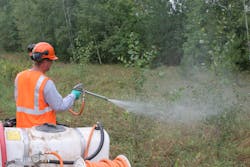Applicators have plenty to consider before, during and after making a herbicide application. Proper handling procedures, mixing rates, safe disposal of containers and personal protective equipment, to name a few. Each step can affect the desired result, which is targeted control of unwanted vegetation.
What is not desired is damaging off-target vegetation, such as ornamental plants on public or private property. In addition to herbicide application errors, there are two other culprits when it comes to off-target damage: volatility and spray drift. Understanding the differences between the two is essential to minimize the effects of each and should be a matter of regular training for newly hired applicators as well as those with more experience.
It’s essential for applicators to first understand the differences between volatility and drift and then take steps to minimize instances of both when making herbicide applications. When either happens, it can lead to off-target damage to desirable vegetation or sensitive crops, with unintended environmental and financial consequences.
Causes of herbicide volatility and ways to minimize it
Herbicide volatility is the result of movement after application when the herbicide converts to a gas and moves from the application site. Volatility can occur when spray solution settles on-site and then changes to a vapor and moves off-site. Herbicide vapor can be carried off-site by wind. Potential for volatility is greatest on inert surfaces where the herbicide is not absorbed, such as rocks and pavement.
Volatility is a characteristic of the formulation of the herbicide and, in some cases, the active ingredient, so not all herbicides have the potential for volatility. When the conditions for volatility are higher, such as higher temperatures and low humidity, using a nonvolatile herbicide will help prevent off-target vegetation damage.
Milestone® herbicide is considered essentially nonvolatile, so it is unlikely to move from the application site as a vapor. This characteristic is based on an active ingredient having a low vapor pressure along with rapid absorption into a plant’s leaf. As a general rule of thumb, the lower the vapor pressure of the chemical, the less susceptible it is to volatility.
Best practices to minimize off-target damage due to herbicide volatility
- Check weather conditions and avoid applying in high temperatures and humid conditions.
- When spraying, avoid applying to impermeable surfaces, such as rocks or pavement.
- Know which herbicide formulations are potentially volatile, such as ester formulations and those with certain active ingredients.
Causes of spray drift and ways to minimize it
Spray drift is a more common concern for off-target injury. Drift occurs when small or fine droplets from the application solution move to nontarget vegetation without ever landing on the target site.
Weather is an important factor contributing to drift potential, including wind speed and direction, air temperature, and humidity. Selecting the proper equipment and treatment method can help minimize spray drift, especially in relation to the droplet size produced. As droplet size increases, the potential for drift decreases. Applicators should always start by referring to the herbicide product label for application guidelines. As an example, all herbicide labels for products from Corteva Agriscience™, Agriculture Division of DowDuPont, include a “Precautions for Avoiding Spray Drift and Spray Drift Advisory” section.
Applicators are responsible for applying herbicides in a manner that minimizes potential risk to people and the environment. This includes exercising good judgment and erring on the side of caution, which will always help mitigate risk, especially when trying to avoid spray drift.
Best practices to minimize off-target damage due to spray drift
- Determine wind direction and try to avoid spraying when sensitive plants are downwind and adjacent to the site.
- Keep nozzle heights as low as possible when spraying.
- Avoid treating taller vegetation upwind when sensitive crops (soybeans, tobacco, grapes, etc.) or water are close or adjacent to the application site.
- Use nozzles that apply coarse, large and uniform droplets (about 400 µm or greater).
- When using an adjustable nozzle, use the coarse (as opposed to the fine) spray setting.
- Don’t rapidly wave herbicide spray wands or guns back and forth as this shears spray droplets and creates more fine droplets that can drift off-site.
- Avoid using worn or improper nozzles and equipment.
- Consider the use of internal or external pressure regulators, such as constant-flow valves.
- Avoid using higher pressures, which tend to generate smaller droplets.
- Consider using drift control additives, which can dramatically reduce drift potential.
- Always follow herbicide label directions.
Sponsored by:
™®Trademarks of Dow AgroSciences, DuPont or Pioneer, and their affiliated companies or their respective owners.
When treating areas in and around roadside or utility rights-of-way that are or will be grazed, hayed or planted to forage, important label precautions apply regarding harvesting hay from treated sites, using manure from animals grazing on treated areas or rotating the treated area to sensitive crops. See the product label for details. State restrictions on the sale and use of Milestone apply. Consult the label before purchase or use for full details. Always read and follow label directions.

